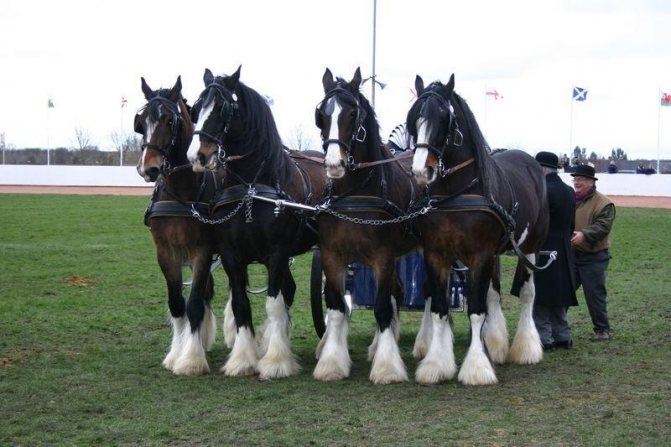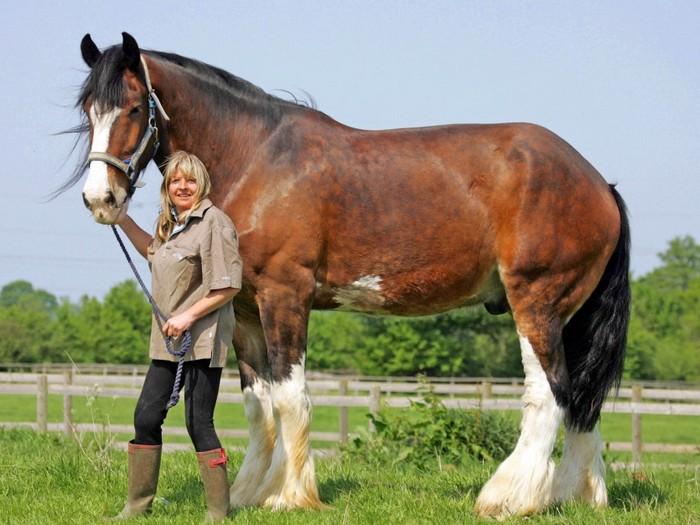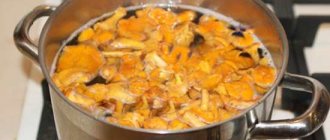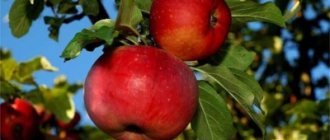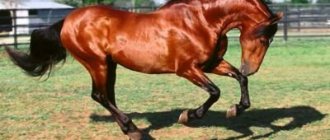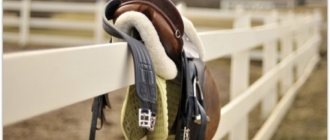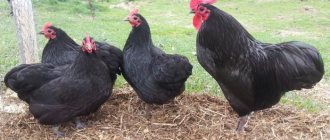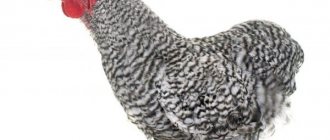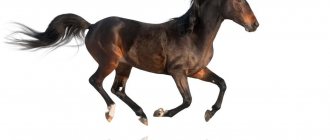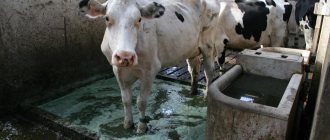5 minutes to read the article
PhotoVideoComments
The Russian heavy draft horse is a domestic breed of heavy draft horses. Through the efforts of breeders, it has collected the best working qualities of European heavy trucks. This is what allows its representatives to consistently take prizes at all kinds of exhibitions. Description of Russian heavy trucks and interesting facts about them - in this article.

A typical representative of the domestic breed of heavy-harness horses - the Russian Ardennes.
Workhorses - Soviet and Russian heavy trucks
| Origin | Ural |
| Suit | More often red and red - roan |
| Height at the withers | from 146 to 150 cm |
| Exterior | Elongated body, short legs, |
| Using | For agricultural purposes, for carrying heavy loads and less often for horseback riding |
The Russian heavy draft horse belongs to the breed of heavy draft horses. Most often they are used to transport large cargo. And although it is not the largest horse in the world, it has sufficient strength and endurance. Differs in remarkable efficiency and longevity, as well as rather high fertility. Unlike many horses, they are absolutely not demanding on living conditions, Russian heavy trucks perfectly adapt to the conditions of the Russian climate.
Origin
The homeland of the Russian heavy horse is the Urals and the work on the breeding of the breed was rather difficult. During the breeding work, Belgian heavy trucks and Russian harness breeds were used.
Also, the blood of the Oryol trotters, Percherons, Brabansons and even Arab thoroughbred horses was repeatedly added.
The main goal was to bring out a horse with sufficient strength, unpretentious and agile, so that he could walk and trot freely.
Appearance
The height at the withers ranges from 146 to 150 cm. The body of the horse is very elongated, however, the legs are slightly short, but they are distinguished by their strength. The head is rather small, but wide, and the neck is muscular. The coat color of such a horse is mainly red or red - roan. Sometimes, very rarely, there is a black and bay suit.
Character
The horses of the Russian Heavy Draft breed are distinguished by their absolutely calm character and good nature. They are smart and level-headed. Thanks to this, they easily make contact with people and serve them well.
The Soviet heavy truck was officially documented in 1952. He was brought out by employees of the Pochinkovsky stud farm No. 23 (Russia). To obtain the breed, the Bityugs, Ardens, Percherons, Brabans, English Suffolks were used. As a result, Soviet breeders received a work horse with the following characteristics:
- height at the withers - 1.6–1.7 m;
- weight - 0.7–1 t;
- the head is of medium size;
- neck - not long, with well visible muscles;
- thoracic region - wide, with rounded ribs, with clearly visible muscles;
- the back is wide, moderately soft, with a straight wide loin;
- limbs - medium in length, differ in strength and dryness;
- tail - slightly overgrown;
- mane - thick;
- color - red, red-roan (main), bay, bay-roan;
- character - sustained.
Advantages:
- high early maturity;
- the ability to consume cheap feed;
- high milk production in mares.
There is only one drawback - there are often anomalies in the development of the limbs in the form of clubfoot.This does not affect the working abilities of equids.
Application
Before the development of small-scale mechanization in the countryside, Russian heavy-harness horses were successfully involved in agricultural work (plowing, harrowing, haymaking) and transportation of goods. On large dairy farms, it was economically justified to use horses to transport feed and water, and to remove manure. Due to their docile nature, horses quickly learn to work and do not cause trouble.
Heavy trucks are distinguished by good meat qualities. Stallions of this breed are used for crossing with outbred or low-value pedigree (Yakut) mares to obtain local large young stock.
The mares are milked, and a valuable fermented milk drink is made from milk - kumis.
In equestrian tourism and rental, small, strong and flexible horses are invariably in demand for riding children and novice equestrians.
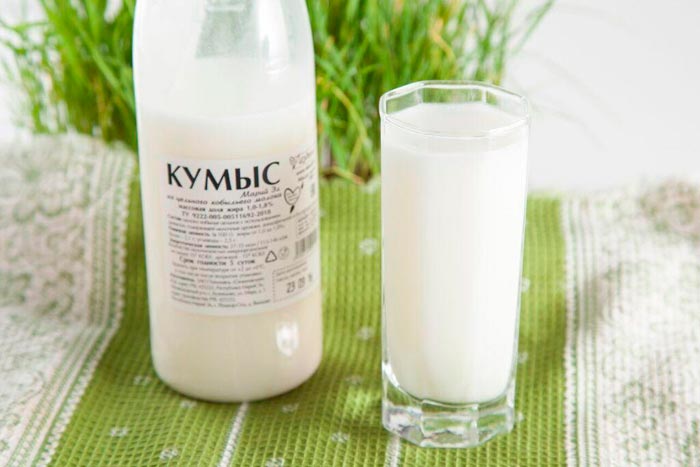

Russian heavy truck - all about the breed and a lot of photos


The height of the horse is 150-153 cm.
Color - red in the bulk, rarely black and red-roan, white markings on the legs and muzzle are required.
Exterior - the smallest domestic heavy-duty truck. Long muzzle, rather dry, the neck is very wide, powerful, the shoulders are straight, the muscular body is placed on short legs, the legs are thick, strong, stable, the hoof is wide, the overgrowth of the mane, bangs, tail and brushes is pronounced.
The distinctive advantages of Russian heavy trucks are absolute unpretentiousness in terms of keeping and feed, long-term service for the benefit of man, and high horse productivity. The last specified parameter concerns the production of dairy products. Mares of this breed give a large volume of milk, from which rare varieties of cheese are produced.
Externally, the horses of the Russian Heavy Draft breed became famous for their medium size and at the same time a light head with a wide forehead, which sits on a short muscular neck, thick chic hair in the mane and tail, as well as long brushes on the limbs.
The constitution of a horse is typical for heavy draft horses, a long strong back, dry constitution, short strong limbs, an even loin and a fairly wide withers.
- Ural type of horse, which differs in elongated limbs covered with voluminous hair.
- A massive type of horse that is large in size compared to other heavy draft horses.
- Novoalekseevsky type of horse, visually similar to the massive type, but slightly smaller in parameters.
The visiting card of a horse of this breed is unshakable endurance, calm good disposition, obedience to the owner.
History of the breed
Approximately one century ago, the Russian people began to actively select the Russian heavy truck breed. The ancient Ardennes, who lived in the Belgian mountains, are recognized as the first ancestors of horses.
At that time, these animals did not look the same, besides, many shortcomings were recorded in the exterior. At the same time, the Ardens quickly covered distances, and their appearance was transformed by the dry constitution of the physique.
People quickly found a common language with these horses, as they ate any food with a special appetite and felt great in any conditions of keeping.
All owners and workers of stud farms tried in every possible way to spread this breed of horses.
And to eliminate the shortcomings of the Ardennes, they were regularly crossed with various glorious horses, in particular, with the Brabancons.
Such works were not in vain, after years the Ardens began to look much more impressive and demonstrate the best qualities.
In particular, the admiration of the audience was awarded to a male named Karavai, a brown horse of this breed. He was even awarded a gold medal as the most valuable graduate of the Khrenovsky stud farm.
In Belgium itself, the breed was suppressed by another more powerful horse - the Belgian working breed. And the Russian people made every effort to preserve the representatives of the Arden breed. Horse breeding set a goal to bring out a low workhorse that can work for the good of the fatherland, while being unpretentious and hardy.
Many horses have become pedigree producers in the selection and breeding of a new breed, in particular horses named Karaul, Casket, Rubicon and Day laborer.
The bred livestock of new horses differed significantly from the Ardens, which were previously familiar to the Russian people. Upon the onset of 1952, the Ministry of Agriculture of the Soviet Union issued a decree stating that the breed should be named - Russian heavy truck.
Historical data
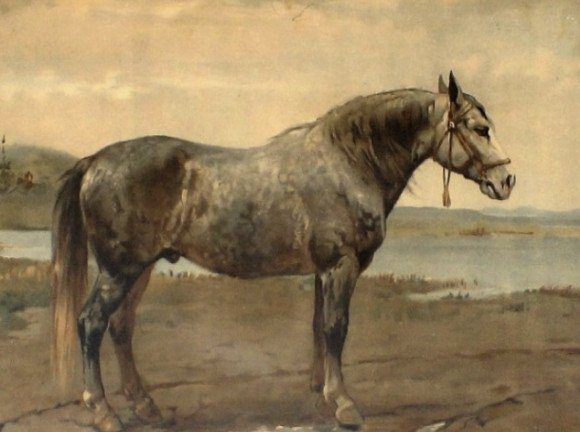

The first representatives of the breed were bred over 100 years ago in the Urals by crossing local individuals with the Arden horse, originally from France and Belgium. The breeding work was carried out to consolidate the following characteristics:
- dry constitution;
- mobility;
- force.
In 1952, following the decree of the USSR Ministry of Agriculture, the breed was given its current name - Russian heavy truck.
Novoaleksandrovsky
This breed is the work of Ukrainian horse breeders who have been improving Russian heavy trucks. Approved in 1948. It contains the genes of the Ardens, Brabansons, Percherons. Description of the exterior of the breed:
- height at the withers - 1.48–1.49 m;
- weight - 0.56–0.59 tons;
- the head is lightweight with an elongated muzzle and a humped profile;
- neck - shortened, wide, massive;
- the back is massive;
- limbs - short, strong, dry, correctly set;
- tail - lush, wavy;
- mane - curly;
- color - savrasaya, black, roan, brown, with white spots on the muzzle and limbs;
- character - balanced, energetic.
Advantages:
- traction power;
- strong immune system;
- excellent fertility;
- excellent milk performance.
The disadvantage is legibility in feed.
History of the breed
There are several varieties of domestic and foreign breeds.
Russian breeds
To date, 3 breeds of Russian horses are known:
- Soviet;
- Russian;
- Vladimirsky.
In the 18th century, the Bityug breed was bred, which completely disappeared at the beginning of the 20th century.
Rank: 1 974
Despite its name, the Russian heavy draft horse breed has its origins in Ukraine, which used to be a single whole.
Powerful and muscular heavy draft horses are very common throughout Russia, from Siberia to the Caucasus, making them the most popular Russian breed of heavy draft horses, which is no coincidence.
The Russian heavy-duty truck is slightly inferior to some other heavy-duty breeds, but it is still an excellent helper and hardy worker in agriculture. These horses grow up very early and are not afraid of either cold or heat. The Russian heavy truck is unpretentious in food and does not require any special care, therefore, practically no costs are required for it.
Read next: Grape lily of the valley description of the variety photo reviews


Russian heavy-duty horse breed (Russian heavy draft)
Historical facts
The direct ancestors of the breed of Russian draft horses were the Ardennes horses, which began to be imported en masse into Russia in the 18th century. The Ardens, or, as they are also called, Belgian heavy trucks, had an unassuming appearance and disproportionate body parts, they were distinguished by a huge reserve of strength, unpretentiousness in maintenance, feeding, care and hard work.
At the beginning of the 19th century, Belgian heavy trucks gained recognition throughout the territory of the Russian Empire and began to be densely used in almost all types of farms. Farmers did not interfere with the crossing of the Ardennes, which led to a change in the breed.
It was very popular among breeders to cross Ardennes and Brabancon horses, which led to positive results and changes in the breed.After that, Russian heavy trucks at the beginning of the 20th century were recognized by the world exhibition in Paris, where the stallion Karavai was awarded the highest award.
At that time, domestic heavy trucks had not yet received their modern name. Then they were called the Ardens from Russia.
Russian heavy truck
After the revolution, Russian breeders began to improve the Russian Ardens even more closely, making them good and hardworking workers, strong, powerful, well-built and unpretentious. Such horses had to work tirelessly in the fields.
The only drawback was the catastrophically small stature, which affected the quality of horse work.
Soon this deficiency was corrected, and in 1950 the heavy trucks were officially named the Russian heavy-harness breed.


The Russian heavy draft horse breed is the pride of domestic breeders. They are medium-sized, well developed physically. These horses have a proportional body, a powerful and strong body, muscular legs, with broad and strong bones.
The ancestors of the breed were the Ardennes horses that lived in the Belgian mountains, which attracted people with their endurance, unpretentiousness and strong constitution. After successful crossing work, a breed was obtained that was adapted to the conditions of a temperate climate, its harsh winters. The animal is not large, but nevertheless strong and obedient, which is important.
A distinctive feature of heavy trucks is a strong and muscular body. They cannot demonstrate good speed, but they do an excellent job with the obstacle course.
Did you know? The maximum weight that a Russian heavy truck can move is 14.5 tons.
Appearance
The breed has its own standards of appearance:
- height - 150-153 cm;
- weight - two-year-old stallion - up to 700 kg, mare - up to 660 kg;
- the head is of medium size with a long muzzle and a wide frontal part with bangs, muscular, strong, short neck;
- body - straight, muscular shoulders, long developed back, wide withers, deep chest and flat lumbar region;
- limbs - even, widely spaced, have brushes;
- mane - thick and long;
- tail - thick, hanging freely;
- suit - red, black and red-roan, the presence of white marks on the legs and muzzle is mandatory.
Character
Horses are balanced and calm, distinguished by obedience and loyalty to the owner. The heavy loader is active in work, peaceful and good-natured. The horse quickly gets used to the conditions of detention and the responsibilities assigned to it.
She is not whimsical and not capricious, she can kick up, if there is a reason for this - for example, feeling unwell or the owner's mistake in caring for the pet.
The breed is bred not only as a labor force, but also to obtain milk and meat; rare varieties of cheese are prepared from the milk of a heavy truck.
Heavy trucks also include breeds such as the Vladimir and Soviet heavy trucks.
In addition, the breed has other advantages:
- adaptability to conditions;
- unpretentiousness in feed;
- calm disposition;
- rapid puberty;
- versatility of application;
- strength and endurance;
- strong nervous system.
The disadvantage of heavy trucks is considered to be gradual degeneration, since mixing with other breeds has a negative effect on the distinctive characteristics. There are very few purebred mares and stallions.
The ancestors of the breed were the Ardennes horses that lived in the Belgian mountains, which attracted people with their endurance, unpretentiousness and strong constitution. After successful crossing work, a breed was obtained that was adapted to the conditions of a temperate climate, its harsh winters.
The animal is not large, but nevertheless strong and obedient, which is important. At an equestrian exhibition in France, a representative of a Russian heavy truck was awarded a gold medal. The official registration of the breed took place in 1952.
Character
She is not whimsical and not capricious, she can kick up if there is a reason for this - for example, poor health or an owner's mistake in caring for a pet.
Breeding features
Breeders have been working for decades to create and improve the characteristics of the Russian heavy draft breed. To preserve its characteristics, the breeding of these animals takes place along the main established lines, within the tribe. Owners of thoroughbred stallions and mares adhere to these principles so that the resulting offspring does not lose valuable traits and qualities.
Mares of this breed are early maturing. Already at the age of 3 years, their growth stops, they are ready for reproduction and work. They are used for breeding for 24-25 years. A newborn foal is born rather large - 230-240 kg. The offspring grows rapidly due to the high milk production of the females.
Attention! A mare for 1 lactation period is capable of producing 2500-3000 liters of milk. The record holder in this area was a horse named Lukoshka, which produced 4800 liters of milk in 305 days.
Belgian heavy truck (Brabancon)
One of the oldest breeds of European heavy draft horses, which was used in the Middle Ages. She was taken out in the Belgian province of Brabant. It was actively used in knightly battles. In Belgium, these horses are considered a national heritage. The exterior of the Belgian heavy trucks can be described as follows:
- height at the withers - 1.6–1.7 m;
- weight - 0.8–1 t;
- the head is small, with a developed wide forehead and a hump;
- neck - short, with pronounced muscles, set high;
- thoracic region - characterized by depth, wide, large, with rounded ribs;
- back - short, strong;
- limbs - short, strong, dry, covered with long dark hair;
- tail - thin, long;
- mane - short;
- suit - red, golden-red, rarely - bay, white;
- character - restrained, kind, flexible.
Advantages:
- rapid development and maturation;
- increased ability to work until old age;
- endurance;
- strong immunity.
The disadvantage is heavy breathing.
Russian heavy truck: breeding work
On breeding work with a Russian heavy truck
The Russian heavy draft horse breed was obtained as a result of systematic selection and selection of undersized, but massive stallions and mares of the Ardennes breed.
The Russian heavy draft is characterized by a small stature (from 142 to 150 cm), a massive, long, deep and wide body with a chest girth of 185–205 cm, short, dry limbs with satisfactory bone development, a medium-sized pedigree head, a short, massive neck.
With a good development of the body and a fairly harmonious physique, horses of this breed often have exterior defects inherent in hatching ancestors. The main ones are a soft back, a short, drooping croup, a sunken wrist, and saber ability.
Fighting mare, Russian heavy truck
Stallion Kolodnik, Russian heavy truck
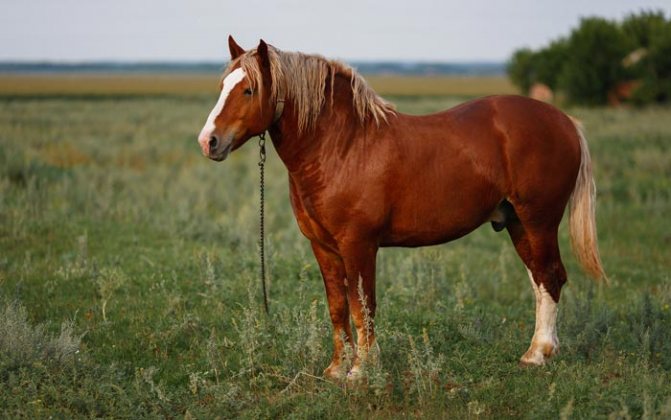

Valuable economically useful traits of this breed include mobility, a long productive stride and a free trot, unpretentiousness to feed and the ability to hold the body with satisfactory feeding, good nature, sufficient strength, in accordance with the type of horse, high fertility, endurance and adaptability to various climatic and economic conditions.
The magnitude of the maximum traction force of the Russian heavy truck is significantly less than that of other comparable breeds, and it is less not only in absolute terms, but also in relation to live weight.
According to the Institute of Horse Breeding, obtained in 1951, the records of the maximum carrying capacity increase as the blood of the Russian heavy truck increases.
The characteristics of the economically useful qualities of the Russian heavy draft and the analysis of its origin show that this breed differs in its qualities from both the hatchery Ardens and other heavy draft breeds.The new type of Russian heavy truck meets the modern requirements of many territories, regions and republics of the Russian Federation, in connection with which it has become widespread.
Read more: Rhodotium for pigeons how to apply for what you need
Determining the direction and methods of breeding work with the Russian heavy truck, it is necessary to increase every year the requirements for the quality of workhorses of collective and state farms in various zones of the USSR, including the zones of distribution of the Russian heavy truck.
Analysis of the history of breeding work in the past shows that long-term, systematic selection and widespread use of stunted stallions as stud sires and the use of inbreeding led to the consolidation and persistent inheritance of small stallions.
For example, the ancestor of one of the modern lines, the stallion Larchik, with insufficient growth - 139 cm had a good oblique length - 154 cm and a chest girth of 193 cm, but the pastern girth was only 20 cm. The same discrepancy in measurements can be observed in other representatives of the lines, for example, the stallion of the Guard - 143-155-187-20 cm.
Small-scale producers cannot raise the growth of local horses even in the primary improvement zones.
Raising the growth of the Russian heavy truck, it is impossible to allow the loss of its existing desirable type. The experience of a number of stud farms shows that when growth is increased without taking into account the need to preserve the type that has developed in this breed, they get, although larger, but atypical for the breed of horses.
Crossbreeding with a Soviet heavy truck can lead to the loss of a number of breed characteristics of the Russian heavy truck and turn it into a small Soviet heavy truck.
Therefore, the main method of further breeding work with the Russian draft horse should be recognized as improving in oneself, due to the selection of larger, but typical stallions and mares. With such a selection and correct selection, it is necessary to simultaneously ensure good conditions for feeding, care and maintenance of the producing compound - mares, stallions and young animals of all age groups.
Particular attention should be paid to improving working qualities: increasing carrying capacity, endurance, speed of movement at walking and trotting.
Data on working capacity must be entered into the factory and herdbooks, where not only the records obtained during official tests, but also data on working qualities when used on the farm at an older age, should be indicated.
It is also necessary to work to increase the early maturity of the Russian heavy draft, which can be achieved by selection for this economically useful trait by good feeding and raising young animals.
The feeding level should be provided according to the guidelines recommended by the Horse Research Institute.
Recommended feeding rates provide all essential nutrients according to horse live weight, age, season and physiological condition.
When working on pregnant mares, the feeding rate should be increased by at least 30% against the recommended sizes for the corresponding non-working group of heavy trucks.
A low level of feeding does not ensure good development of young animals, which is why its quality decreases, and hence the price for sale decreases. It is economically more profitable to raise young animals of the elite and first class with adequate feeding and rational maintenance, than with poor feeding, to grow products that meet the requirements of the second class.
During the breeding season, stallions should be provided with moderate daily
exercise by riding in a harness or releasing into a levada.
Young animals in the summer should use pasture maintenance, and in the winter they should be released for long walks in the levada and conduct group training with the whole herd in the steppe along a certain route for 1.5-2 hours at a distance of 8-10 km.
Ride, dressage and training of young animals should be carried out in accordance with the instructions of the Research Institute of Horse Breeding, taking into account the possibility of using young horses for on-farm work. The work carried out on young animals must be taken into account and the quality of their performance must be assessed Yakovlev, professor
Economic value
The field of application of the breed is not only draft work, although it is here that Russian heavy trucks show excellent results. Due to their excellent conformation and other performance characteristics, they are often used as improvers (for example, for short northern horses).
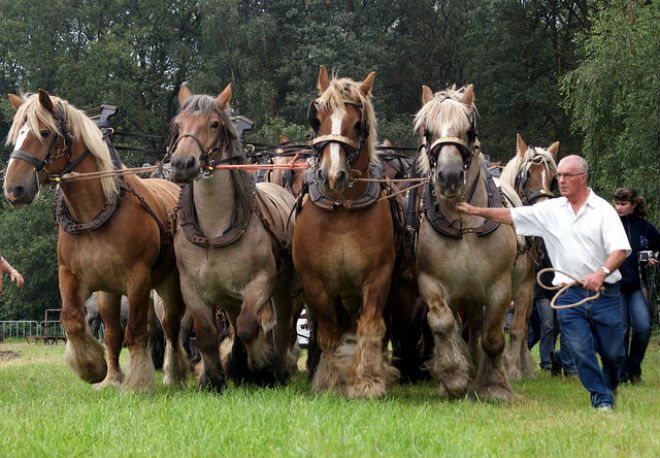

The main use of the breed is to work as a draft force.
When Russian "strands" are crossed with steppe horses, highly productive meat hybrids are obtained, which, when grown in herds by 70 kg, bypass their local peers in weight.
Another promising direction for the use of the breed is dairy. The All-Russian Research Institute of Horse Breeding at its kumis farm receives from 3 to 4 thousand liters per lactation.
On trials, Russian heavy trucks break all records. These horses cover the distance of 2 km with a hayload of 1.5 tons in 5 minutes. The maximum traction force of the Russian heavy is astonishing - 26 tons.
Percheron
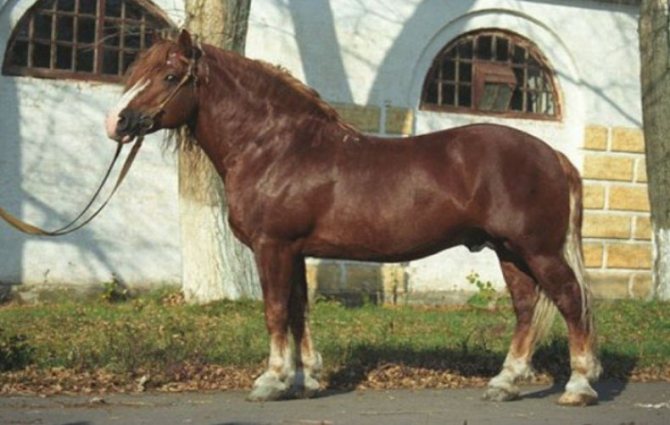

The Percherons are natives of France at the beginning of the 19th century. The French managed to cross the local draft horses with Arabian horses. The main goal of such a cross is to obtain a fast horse capable of transporting heavy loads. The main exterior characteristics of the Percherons:
- height at the withers - 1.75 m;
- weight - 0.8–0.9 t;
- the head is wide with a straight profile;
- neck - long;
- thoracic region - wide, reaches 2 m in girth;
- back - elongated;
- limbs - strong, with developed joints, there are no brushes on the front limbs;
- mane - lush, beautiful;
- suit - gray, occasionally black;
- character - energetic, good-natured, obedient, not capricious.
Advantages:
- excellent adaptation to any living conditions;
- strong immune system;
- the ability to endure heavy loads for a long time without rest;
- the ability to graze on pasture all year round.
There are no disadvantages.
Lifestyle in nature
In order to find an approach to such a horse, you need to know its main character traits, requirements for maintenance and care, as well as food preferences.
Character and habits
The nature of the Russian heavy truck is simple - unprecedented endurance, recognition and obedience to man, a high indicator of mobility and energy. Thanks to these characteristics, the horse is ideal for agricultural work. A calm and balanced horse quickly gets used to a new owner, adapts to any living conditions within reason and quickly fits into the work schedule. But if something goes wrong, the horse can show his character by kicking slightly.
Breeding and keeping
If a farm contains about 100 mares of a Russian heavy truck, they account for about 85% of the brood of foals. In addition, one mare is capable of breeding for 20-25 years. Mares with stallions are bred and kept on village farms, where animals undergo training sessions and demonstrate their skills. After that, the breeder easily selects the most able-bodied stallions and promising mares.
Horses are considered early maturing breeders, already at the time of 1.5 years, the stallion reaches full height at the withers, comparable to an adult. At this age, 75% of stallions also gain the required body weight. And already at the time of the third year they stop growing. A free open-air enclosure in the form of a tent will be enough for a horse.
Food
Despite the unpretentiousness and easy adaptation to weather conditions, Russian heavy trucks need plenty of drink. Any vegetation preferred by other horses will do as food. Heavy trucks will be happy with any feed, despite its high cost and value. This can include fresh grass, hay, solid forages and grains.You can feed horses to maintain energy and performance with concentrated feed, vitamins and minerals. Horses love carrots, beets and sugar, which are often encouraged by animals.
English heavy truck (Shire)
Shires are direct descendants of the knights' horses. Formed in the 18th century as a result of mating of local breeds with the Flemings and the Dutch. These are the largest horses in the world. Initially, they were used on the battlefield.
Then they were adopted in agriculture, industrial production, on the railways, at the docks.
Features of Shires:
- height at the withers - up to 1.9 m;
- weight - up to 1.3 t;
- the head is massive, heavy with a large, wide frontal lobe;
- neck - short, straight;
- back - short, well developed;
- croup - long, well muscled;
- limbs - hardy, powerful, with fluffy friezes;
- tail - set high, lush;
- color - bay, krak, gray, red, with white stockings more often on the hind legs;
- character - obedient, calm, balanced, peaceful.
Advantages:
- beautiful exterior;
- endurance;
- obedient disposition.
Disadvantages related to the exterior:
- damp feet;
- strong freeziness;
- insufficient squat;
- exactingness to feed.
Did you know? ” , 5 t.
Boulogne horse
The breed is ancient, recognized in the 17th century. Bred in the French province of Boulogne. There are 2 types: large heavy and small. The following features are inherent in the Boulogne heavyweights:
- height at the withers - 1.50–1.65 m;
- weight - 0.7–0.9 t;
- the head is graceful, with a regular profile and a high forehead;
- neck - well-muscled;
- thoracic region - deep, with rounded ribs;
- the back is wide, straight;
- limbs - strong, short, muscular;
- tail - set high, thick;
- mane - wavy, short;
- suit - gray (main), rarely bay, red;
- disposition is kind.
Advantages:
- increased efficiency;
- unpretentiousness;
- well-developed musculoskeletal system;
- the ability to develop high speed of movement;
- endurance.
The disadvantages include the fact that the breed has practically disappeared.
Cleydesdale (Scottish cold-blooded horse)
The breed appeared in the second half of the 18th century. Her homeland is Scotland. The unusual exterior made it possible to use the horse not only for heavy work, but also for participation in solemn ceremonies. Typical signs:
- height at the withers - 1.67-1.84 m;
- weight - 0.82–0.91 t;
- the head is powerful, with wide frontal lobes and muzzle;
- neck - elongated, with a good bend;
- the thoracic region is deep, with steep ribs, with a coverage of 165–205 cm;
- back - shortened;
- limbs - straight, with correct positioning and well-developed brushes;
- tail - straight hanging, not too long, distinguished by splendor;
- mane - straight, lush;
- suit - bay, brown, black, with white spots around the head and limbs, which can capture the lower part of the body;
- character - good-natured, balanced.
Read next: How to make a do-it-yourself chicken feeder
Advantages:
- endurance;
- high carrying capacity;
- good adaptability to any natural conditions;
- elegant exterior.
Disadvantages:
- damp feet;
- the need for high quality care and feeding.
Arden horse
These equids were known even under Julius Caesar. At the beginning of the twentieth century, they were used in military conflicts, for transporting artillery pieces and in cavalry. Later, their abilities were useful in agriculture, equestrian sports. Also, these horses are allowed to produce horse meat. Exterior features:
- height at the withers - 1.6–1.62 m;
- weight - 0.7–1 t;
- the head is heavy with a wide low forehead and a slightly convex profile;
- neck - differs in average length;
- thoracic region - characterized by depth;
- the back is shortened, with a muscular lower back;
- limbs - strong, with strong joints;
- the mane is lush;
- color - red, bay, black-gray, bay-roan, with white spots in the shape of a star;
- character - submissive, unpretentious, gentle.
Advantages:
- high productivity of meat products;
- working capacity;
- vitality;
- large carrying capacity;
- unpretentiousness to feed and care measures.
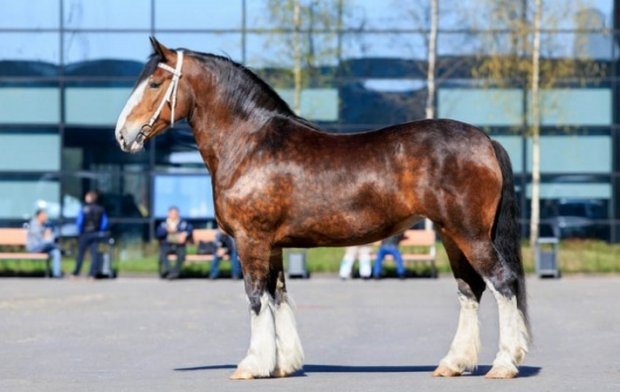

Disadvantages of the breed have not been identified.
Important: Heavy Draft Horses should work no longer than 6-8 hours a day, with an hour's rest.
Exterior
Many cold-blooded horses look rather massive compared to warm-blooded horse breeds. They are almost never used in equestrian sports, as they are not endowed with flexible movements due to their stocky body constitution. However, many horse lovers are attracted to these animals by the following characteristics:
- The softness of the gait. "Heavy" are not capable of fast movements, high jumps and graceful dressage elements. However, gait, stride-trot-gallop (a career for the "heavy" is virtually impossible due to the weight of the body and the thickness of the legs) is very comfortable for the rider. Despite the fact that heavy trucks are tall and large, they are comfortable to ride. Their body, when moving, is not able to rise high above the ground, therefore, the shaking in the saddle will never be strong.
- Dimensions. The heavy truck, like many other breeds, has its own ancestors. In the Middle Ages, mainly in European countries, the ancestors of heavy draft horses were considered for the most part knightly horses, and only then - heavy-harness farm horses. In the distant feudal times, these large horses were called "destrie" (dextarius), which means "right-handed" in Latin. Perhaps the heavy horse giant received such a name, because on the right side of the warrior, who was sitting on a horse, was accompanied by his personal squire.
The weight of a heavy horse of that era ranged from 800 kg to 1000 kg, and sometimes even more. The height was from 170 cm to 200 cm, which, in accordance with the weight, was a portrait of a very large, heavy horse, not capable of a fast gait. Despite the fact that such a representative of an equid did not have hefty power and could carry a heavy load of armor and weapons of a knight (including the knight himself, and sometimes the lady of the "heart" to boot), he did not always have enough endurance at long distances ... He quickly fizzled out.
- The sight of a powerful horse evokes at least respect for an observer who is indifferent to the horse family. If for some time to communicate with the "heavy", then their calmness, peacefulness and charm can conquer. After all, many of these horses have a good-natured and docile nature. They get along well not only with adults, but also with children, and even with other animals. According to many breeders practicing breeding of these horse breeds, it should be noted that among them there are not so many aggressors and rebels in dealing with humans, despite their significant size.
- The priority in carrying out pedigree work on the breeding of heavy trucks is to improve their genetics (hereditary qualities), which allow the descendants of “heavy trucks” to acquire such qualities as high carrying capacity, adaptability to harsh climatic conditions and unpretentious care and diet.
The exterior quality of heavyweights is in second place after strength qualities, since in most countries (especially in Russia) they are bred mainly for rural work, and only then for specialized entertainment competitions. Also in Russia, the "cold-blooded" horse is often popular with horse riding enthusiasts.
To check the quality of the bred (produced) breed, many large breeders of breeds arrange various events for the "heavy" for the "heavy" tests.Most often, this is the transportation of maximum weights for the speed and duration of the distance over rough terrain with certain obstacles (puddles, rises, uneven terrain, etc.).
Such competitions are gaining popularity every year, since they are sometimes not inferior to classical equestrian sports in terms of entertainment and extremeness.


Among heavy trucks, various strength testing activities are often carried out, for example, transporting maximum weights at speed and length of distance.
- The softness of the gait. "Heavy" are not capable of fast movements, high jumps and graceful dressage elements. However, gait, stride-trot-gallop (a career for the "heavy" is virtually impossible due to the weight of the body and the thickness of the legs) is very comfortable for the rider. Despite the fact that heavy trucks are tall and large, they are comfortable to ride. Their body, when moving, is not able to rise high above the ground, therefore, the shaking in the saddle will never be strong.
- Dimensions. The heavy truck, like many other breeds, has its own ancestors. In the Middle Ages, mainly in European countries, the ancestors of heavy draft horses were considered for the most part knightly horses, and only then - heavy-harness farm horses. In the distant feudal times, these large horses were called "destrie" (dextarius), which means "right-handed" in Latin. Perhaps the heavy horse giant received such a name, because on the right side of the warrior, who was sitting on a horse, was accompanied by his personal squire.
- The sight of a powerful horse evokes at least respect for an observer who is indifferent to the horse family. If for some time to communicate with the "heavy", then their calmness, peacefulness and charm can conquer. Indeed, many of these horses have a good-natured and docile nature. They get along well not only with adults, but also with children, and even with other animals. According to many breeders practicing breeding of these horse breeds, it should be noted that among them there are not so many aggressors and rebels in dealing with humans, despite their significant size.
- The priority in carrying out pedigree work on the breeding of heavy trucks is to improve their genetics (hereditary qualities), which allow the descendants of "heavy" to acquire such qualities as high carrying capacity, adaptability to harsh climatic conditions and unpretentious care and diet.
Among heavy trucks, various strength testing activities are often carried out, for example, transporting maximum weights at speed and length of distance.
Soviet heavy draft horse - the breed of horses is highly valued all over the world. No other breed has such a lush bouquet of advantages and benefits that are appreciated at the highest level. Soviet heavy trucks ripen and grow up early, produce huge amounts of fat milk and show themselves as first-class and hardy workers.
Breeding history
A huge amount of blood was mixed in Soviet heavy-duty horses. To breed this unique breed, the Brabancon, Percheron breed, as well as Bityugs, Suffolk horses and Ardennes were used.
Soviet heavy truck
The history of the horse breed of Soviet heavy trucks began in the middle of the 19th century, when Brabancons began to be massively imported in Russia for heavy work. They were excellent workers, but absolutely not adapted to the harsh Russian climate. Horses were often sick, so they died, and crossing them with local hard-working breeds solved this problem.
Soviet heavy trucks were bred at the Nizhny Novgorod and Moscow stud farms. The hatching process was very difficult and lengthy, but the result exceeded all expectations.
Read more: Breeding and keeping pigs at home
Soviet heavy-drawn horses are very submissive and calm. They are born for tough working and climatic conditions.Soviet heavy trucks have the strongest immunity and are extremely rarely susceptible to diseases, which is so appreciated by agricultural workers.
Calm disposition
Exterior
These draft trucks not only have a well-developed system of organs of movement (muscles), they are also unusually beautiful. Unlike other breeds, the head of a Soviet harness horse is medium and proportional, with a beautiful, expressive muzzle.


Their bodies are long and strong, with a wide and powerful chest. The legs of the horses of the Soviet draft horse breed are very strong and muscular. The hooves are strong and flat, thanks to which horses can move easily even on loose and marshy soil.
The Soviet heavy-harness breed is more often found in red color with a mane and a tail of medium length. Moderate grooming of the horse does not require clipping and grooming of the animal's coat.
Massive constitution
The Soviet heavy draft horse is a horse breed with high productivity and a fast maturation rate. They are gaining weight and height very rapidly. A one-year-old foal can weigh more than half a ton. With the onset of the age of two, they are actively used in hard work, and after 5 years they are allowed to participate in specialized competitions.
One of the distinctive features is the possibility of long-term breeding operation. Individual mares give offspring at the age of twenty and older.
They are picky about food, the willingness to consume cheap feed, the ability to live in any difficult conditions, makes the maintenance of Soviet heavy draft horses very profitable and attractive. Mares are very productive during the lactation period and give an average of about 6,000 liters of milk. This feature has been successfully used to improve the quality of the local workhorse breed.
The Soviet heavy draft horse is a horse breed that was bred at the Pochinkovsky and Mordovian stud farms. Despite this, two species of the breed were identified with their own characteristics and differences.
Individuals bred at the Pochinkovsky stud farm are very similar to heavy trucks. Their body is massive, elongated, and has high legs.
Mordovian horses are more similar to the Sufolk breed and, accordingly, their constitution is not so massive and drier.
Briefly about records
Speaking about these horses, I would like to mention her achievements and records. At the hippodrome in Tambov, in 1957, a bay-roan stallion named Force became the record holder in carrying capacity.
He covered a distance of 35 meters with a load of almost 23 tons, thanks to which he became an absolute record holder.
Further, at all-Union competitive events, for 30 years since 1960, the best representatives of this breed won prizes and set new records.
Life does not stand still, and with the advent of modern technical innovations and their introduction into agriculture, it eliminated the need to use heavy trucks.
At the moment, the breed is going through a rather difficult period, despite its such high results. The number of purebred individuals is rapidly decreasing, highly productive queens are no longer in demand, and the demand for them has dropped sharply.
Maintenance and care
Heavy trucks are famous for their unpretentiousness.
Here are some guidelines for keeping and feeding them:
- You need to keep horses in stalls measuring 3.5 by 3.5 m per 1 individual and a ceiling height of 3 m.
- It is necessary to ensure that there are no drafts in the stalls, but good ventilation must work.
- On the floor of the stall, there should be 15 cm of litter.
- On the walls, at a level of 60 cm, you need to equip feeders and a drinking bowl made of natural materials.
- In winter, the stall must be kept illuminated for 16 hours.
- Litter, feeders and drinkers should be cleaned daily.
- Horses should spend most of their time walking in the pasture. So they will maintain their muscles at the proper level.
- After work, a warm shower is required, except for the winter period.In winter, it will be enough just to clean and comb the wool and hooves.
- Regular check-ups by a veterinarian are required - 3-4 times a year.
- A large physique leaves an imprint on the characteristics of feeding. The menu should be based on fresh grass in summer and hay in winter. Also, it must contain cereals, root crops, vegetables, vitamin and mineral supplements.
- The water in the drinking bowls should be warm - the temperature is not lower than 20 degrees.
So, we looked at the best heavy draft horse breeds. All of them have several similar features: a large, massive body, endurance, strong immunity, high efficiency, kind, docile character, balanced nervous system, unpretentious care.
Important! Concentrated feed in the diet of heavy draft horses should make up 25% of the total feed, juicy - 35%, coarse - 40%.
Today they are not so often used for the transportation of goods, but are more used in farming, tourism, equestrian sports, for organizing leisure time, for breeding other breeds, for obtaining meat and milk, in hippotherapy.
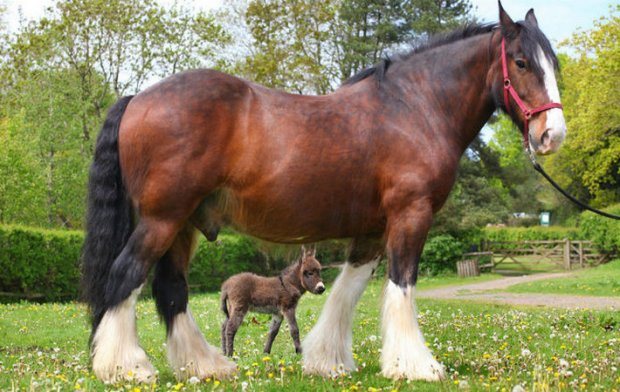

Despite the simplicity of the conditions of detention, it is still worth following some rules, especially with regard to the hygiene of the animal.
Stable conditions
Horses are kept in accordance with the following rules and regulations:
- Horses are kept in so-called stalls. Size per individual - 3.5x3.5 m, not less. The ceiling height is about three meters. Drafts are contraindicated, therefore there should be no cracks in the room, ventilation is required for constant access of fresh air.
- Straw or sawdust is used as bedding, it is laid at least 15 centimeters in height.
- Feeders and drinkers are located on the back of the fence at a height of about 60 cm, they should be made of natural non-toxic material up to 30 cm deep so that the feed does not spill.
- Scientifically substantiated 16-hour illumination, brightness of about 150-200 lux, in winter this method eliminates winter lethargy inherent in horses.
- There should be a paddock near the enclosed space.
Learn how to harness your horses properly.
Record animal performance
Representatives of heavy draft horse breeds became famous for many records, which were recorded by admiring owners and the public. Several impressive record numbers:
- The highest growth was recorded in the Sampson gelding of the Shire breed - 219 centimeters. Sampson's weight is 1524 kilograms. The horse was born in 1848, when the book of records was not yet kept. These figures are considered record-breaking, they have not yet been surpassed.
- The Guinness Book of Records recorded another representative of the Shire breed - the gelding Goliath with a height of 193 centimeters.
- Percheron Morocco (weight 1285 kilograms) and Brabancon Brooklyn Supreme - 195 centimeters had an impressive height of 215 centimeters.
- Heavyweights became famous not only for their size, but also for their draft power. A photo of 1893 has survived, in which a pair of Shire horses pulling a cart with a forest weighing 42 tons. The strongmen drove the loaded sleds through the snow at a distance of 500 meters.
- The draft capacity of heavy trucks was measured at horse shows. Gelding Volcano at Wembley created a thrust of 29 tons, which was recorded by a dynamometer. A pair of harnessed shires showed a result of 51 tons.
See also
Characteristics of Akhal-Teke horses and maintenance rules, how much it costs
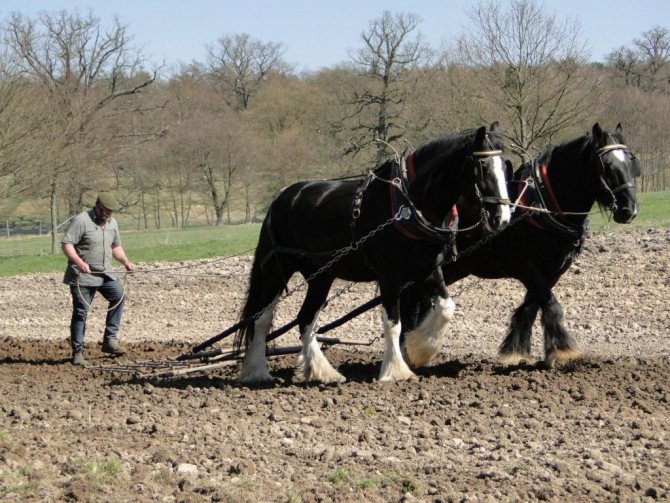

The decline in interest in heavy trucks is noted due to the development of technology. Records were recorded in the 19th and early 20th centuries, when the possession of powerful horses brought benefits and made work easier. Farmers were proud of their thoroughbred, strong horses; horse breeders were looking for fame in order to sell young animals from farms at a higher price.
Reference: mares of many heavy draft breeds during lactation give 5-6 thousand liters of valuable kumis, which has valuable properties.


